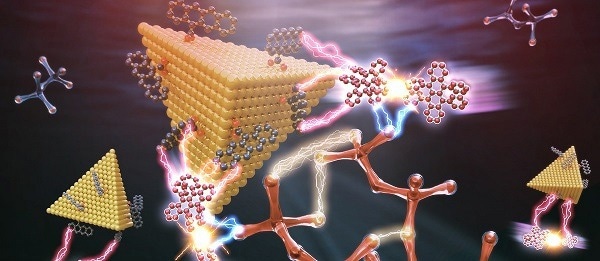Under the guidance of Professor Kaifeng Wu from the Dalian Institute of Chemical Physics (DICP) of the Chinese Academy of Sciences (CAS), a research team has presented efficient near-infrared photon upconversion sensitized by lead-free semiconductor nanocrystals and illustrated its novel application in solar synthesis.

Near-infrared photon upconversion and solar synthesis using lead-free nanocrystals. Image Credit: by DU Jun.
The study was reported in the Nature Photonics journal on February 6th, 2023.
Upconversion of near-infrared photons to visible photons has the potential to promote the performance of photoredox-catalysis, photovoltaics, and phototheranostics. Sensitized triplet-fusion is considered to be a useful means for photon upconversion.
However, the present photosensitizers often consist of either valuable or hazardous elements, for instance, lead chalcogenide nanocrystals and palladium- or platinum-complexes.
In this study, the scientists reported zinc-doped CuInSe2 nanocrystals as an affordable and environmentally-benign sensitizer available for near-infrared-to-visible upconversion, obtaining external quantum efficiency of 16.7% for this spectral range.
Further, this upconversion system was integrated with photoredox catalysis, thereby allowing amine oxidation, reductive dehalogenation, carbon-oxygen bond formation, and photopolymerization effectively guided through near-infrared photons.
Most significantly, as a result of the broadband light capturing of the near-infrared nanocrystals, such reactions were notably quick under indoor sunlight, allowing, for instance, the polymerization of acrylates within just 30 seconds.
Organic synthesis under sunlight, or solar synthesis, has been a century-long idea, which was pioneered by Ciamician et al. But organic chemists' vision has been limited to utilizing visible photons in sunlight.
Kaifeng Wu, Professor, Dalian Institute of Chemical Physics, Chinese Academy of Sciences
Wu added, “Our study extends the reach of solar synthesis to both visible and near-infrared photons abundant in sunlight, which is poised to strongly boost this technology.”
Journal Reference:
Liang, W., et al. (2023) Near-infrared photon upconversion and solar synthesis using lead-free nanocrystals. Nature Photonics. doi.org/10.1038/s41566-023-01156-6.